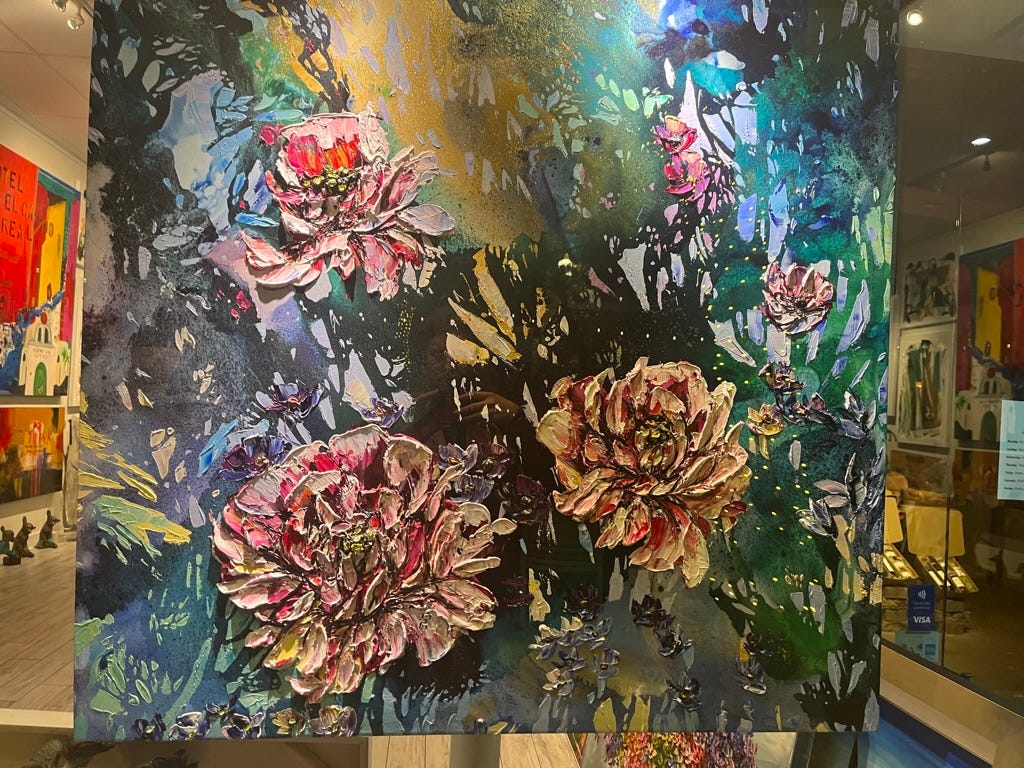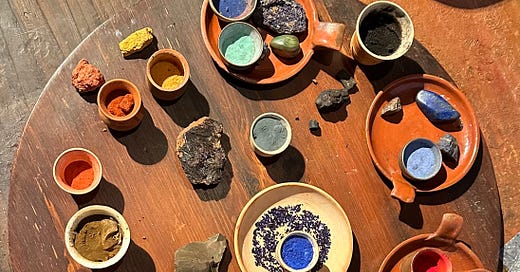This is Part 2 of my Paint Mill Series. Start with Part 1.
Everyone whip out your smocks and palettes. In this article we will get elbow deep into the dirty details of the substance that colors our lives and apparently covers the Earth, according to the ads of Sherwin Williams’ haunting past.
Embarking on my exploration of paint sustainability from the Dutch Golden Age to today, my initial challenge was understanding the essence of what makes paint, well, paint. From watercolor to tempera, a range of mediums decorated the eras, so I chose to focus on the dominant types from each: oil and acrylic paints, respectively.
Fundamentally, paint is made of pigments and liquids (binders), and the variability of these elements drives environmental impact just as much it imparts luster, consistency, durability, opacity, and adhesion.
Let's delve into these colorful elements, from pigment to polysiloxane, to tease the role paint mills play in the larger narrative of sustainability.
Pigments

Pigment (n.): a substance used to impart color, usually derived from plant or animal tissue.
Color is the companion of life. Our cheeks blush when we feel flattered, embarrassed, and enraged, and they drain when we are cold and dead. Ironic, then, is it that the pursuit of vibrant pigments throughout history has often been laced with environmental and ethical dilemmas, even death. Consider the origins of some of Rembrandt van Rijn’s cherished selections, each with its unique and often harrowing backstory:
Tyrian Purple, secreted from predatory sea snails, demanded the sacrifice of thousands of mollusks per gram of pigment.
Black/brown, derived from the ashes of mummified bodies, exemplified the macabre lengths once taken for artistic excavations.
White, sourced from hazardous white lead, showcases the health risks associated with certain traditional pigments.
Ultramarine, mined from the precious lapis lazuli stone, demonstrates the opulence and rarity associated with certain hues.
Carmine, extracted from crushed cochineal bugs, exemplifies the unconventional sources explored for achieving vibrant colors.
Yellow, drawn from sources as diverse as earth clay, bile, and even cow urine, highlights the resourcefulness of historical artisans.
Emerald Green, a product of the chemical industry, echoes the unintended consequences (e.g., the death of Napoleon Bonaparte) of progress.
The intricate web of historical pigment production unravels a tapestry of ecological concerns, including resource scarcity, health hazards, and technical inefficiencies, all of which contributed to the overall environmental impact of the artistic process.
Many pigments evidently required precious or scarce material sources, walking the thin line of exploitation. Some also created health issues through air and skin exposure to heavy metals (e.g., lead, arsenic), animal rights and biodiversity challenges, and other heaps of waste, all of which should be factored into the calculation of their footprints. Unfortunately, due to a lack of data from the post-Renaissance manufacturing period we cannot confirm how much of a factor they actually had.
In the 17th century, pigments were entirely derived from organic and inorganic sources, altered by heat and hydration to attain the perfect hue. While some of these pigment sources still exist today, many of them have been replaced by less expensive, synthetic alternatives following the first chemical synthesis of pigment in 1704. The supply chain of synthetic pigments is complex: some are made from recycled steel and auto parts, some from coal tars, and others purely chemical synthesis and oxidation. As this industry evolution occurred, chemically synthesized pigments became increasingly destructive but over the long term have simmered down with efficiency.
But can we definitively say whether historically natural or modern synthetic pigments are more sustainable?
Natural, particularly organic, pigments tend to be more conducive to a sustainable production cycle because they somewhat depend on the short-term regeneration of nature to be replenished (i.e., reproduction of snails, production of bile, decay of mummies). At the same time, certain, particularly inorganic, sources can be equally if not more damaging to the environment and human health than synthetic pigments. Short answer, no.

Binder (n.): Binders are used to form films in combination with pigments to allow paints to be applied to substrates for artistic applications.
Did you know your morning scramble could have been used for artistic mastery?
In the bygone era of the Dutch Golden Age, egg yolks and linseed oil played central roles as binding agents for tempera and oil-based paints. While these traditional mediums had their pitfalls, their organic origins and versatile applications also promoted somewhat of a harmony with nature:
Tempera: On the sunny side, eggs can be cultivated (and composted) pretty much anywhere. Just as today, eggs were considered a household staple, but unlike today, they were primarily sourced from local farms, thereby negating the modern concerns with factory farming.
Oil: Linseed (i.e., flaxseed) oil also has a relatively low footprint, as the environmental impacts of agrochemicals (i.e., pesticides and fertilizers) associated with the Green Revolution of agriculture had not yet ticked up. There was, however, the waste created in the production of oil from extruded fibrous material, called flaxseed oil cakes. (P.S. Check out this tutorial of how to make your own linseed oil at home for some insight into the process). While I could not find any evidence to confirm the use of these oil cakes during the Baroque era, there are eight suppliers in the U.S. today purchasing them for use in baked goods as a form of industrial symbiosis and waste recirculation (good on them!).
In contrast, modern acrylics, with their complex chemical compositions, present a convoluted lifecycle narrative. One online directory for paint products contains 10,000 different resin/polymer formulations, 9,000 additives, and 4,500 pigments and fillers. While the ingredient list for your run-of-the-manufacturing-mill acrylic paint is longer than a CVS receipt, there is some consistency in formulation to help assess environmental impact. Acrylics tend to be composed of about 41% water, 32% resin, and 6.5% pigments and other additives. Scratching the surface of these ingredients and their ramifications sheds light on some pressing concerns:
Resin, derived from extensive processing of natural gas polymers, stands as a stark reminder of the environmental toll of fossil fuel derivatives (e.g., greenhouse gas emissions and (non)biodegradability).
Stabilizers like propylene glycol, also derived from natural gas, echo similar concerns associated with resin.
Thickening agents, powders, preservatives, and other additives include talc, titanium dioxide, paraffin, and silicon defoamers, respectively. Talc known to contain asbestos is considered a human (and wildlife) carcinogen. Titanium dioxide has proven to be toxic on mammalian and aquatic species. Paraffin is a non-biodegradable lubricating oil that decreases porosity of soil, contaminates aquatic ecosystems, and bioaccumulates in animal and plant tissue. Silicon defoamers, often made of polysiloxanes, primarily end up as air emissions and have been shown to cause endocrine disruption.
Navigating the lifecycle complexities of both acrylic and oil-based binders punctuates their respective effects on the land, water, air, and waste management systems.

“Green paint” (n.): emission-free, VOC-free paint without chemicals that could harm consumers, including pregnant women, babies, and people with asthma.
From the full lifecycle perspective, the processing of raw materials used to produce paints is the largest contributor to their environmental impact. The quest for greener shades has prompted numerous claims, often leading to disillusionment and false marketing ploys (gluten-free, vegan paint, anyone?).
The U.S. Federal Trade Commission has broached false statements by paint companies claiming to be emissions-free and/or suitable for consumers with multiple sensitivities through their ‘Green Guides.’ In reality, the companies could present no evidence that these claims were actually true, and in some cases were actively proven as false. As of 2023, two cases have been made against half a dozen companies barring them from producing or distributing any marketing materials furthering the use of these claims.
But there are still companies out there doing green work. One notable example involves the innovative approach of Ohio-based True Pigments, which repurposes iron oxide from acid mine drainage, exemplifying a tangible commitment to both artistic expression and environmental restoration.
As hopefully demonstrated by these intricate narratives, the pursuit of sustainable paint demands a nuanced understanding of organic pigments, waste reduction strategies, and conscious material choices, among other factors, which transcend the rhetoric of green advertising.
Join me in the next segment of this series as we unravel the deeper complexities of sustainable paint production, exploring the interplay between history, production technology, and a greener future.
P.S. As a sustainability buff, I know that this space is somewhat siloed and constantly evolving. Being said, I welcome your fact-checking and feedback! Working together to improve our collective understanding of sustainability is the goal of my page!
P.P.S. The views in this article are my personal perspectives and do not necessarily reflect the view of my employer or any other person or entity.
Connect with me on LinkedIn & subscribe to my Substack.






